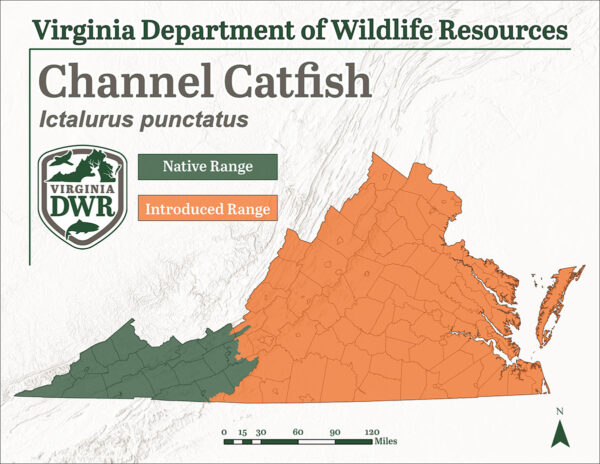District 4 Fisheries Biologist Jonathan Harris handles a Channel Catfish during biological processing.
A Channel Catfish captured during an electrofishing survey. ©Evan Visconti
Fact File
Scientific Name: Ictalurus punctatus
Classification: Fish, Order Siluriformes, Family Ictaluridae
Size: Mature Channel Catfish in Virginia average around 20 inches in length, but large specimens can surpass 30 inches
Life Span: Channel Catfish can live for up to 30 years in Virginia waters
Identifying Characteristics
- Whiskers along the lower jaw and corners of the mouth
- Adipose fin
- Spines present in the pectoral and dorsal fin
- Smooth body, absent of scales
- Elongated body with a deeply forked tail
- Rounded anal fin
- Colors can vary from slate blue, to olive. Most specimens have a peppering of black pigmentations
Diet
Channel Catfish are omnivorous feeders, consuming fish, crustaceans, amphibians, aquatic plants, and small mammals when opportunity presents itself.
Distribution:
Channel Catfish are native to the Upper Cumberland, Tennessee, and New River watersheds in southwest Virginia. They have been introduced elsewhere throughout the Commonwealth as a valued culinary and recreational resource.

Habitat
Channel Catfish can inhabit a diversity of habitats but are most associated with pools and runs with moderate levels of current. Channel Catfish often seek out areas with silty substrates that have overhanging cover.
Reproduction
Channel Catfish spawn between April and June in Virginia. Males build nests in concealed locations, either under structures or within a burrow. As females release eggs, the males fertilize them. Male Channel Catfish remain with the fertilized eggs, continuing to incubate them by fanning and cleaning them as they develop. Eggs hatch 5 to 10 days after fertilization.
Last updated: August 14, 2024
The Virginia Department of Wildlife Resources Species Profile Database serves as a repository of information for Virginia’s fish and wildlife species. The database is managed and curated by the Wildlife Information and Environmental Services (WIES) program. Species profile data, distribution information, and photography is generated by the Virginia Department of Wildlife Resources, State and Federal agencies, Collection Permittees, and other trusted partners. This product is not suitable for legal, engineering, or surveying use. The Virginia Department of Wildlife Resources does not accept responsibility for any missing data, inaccuracies, or other errors which may exist. In accordance with the terms of service for this product, you agree to this disclaimer.

